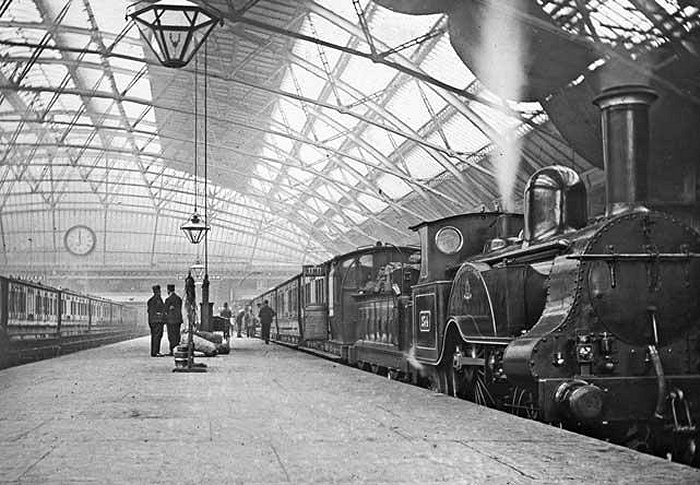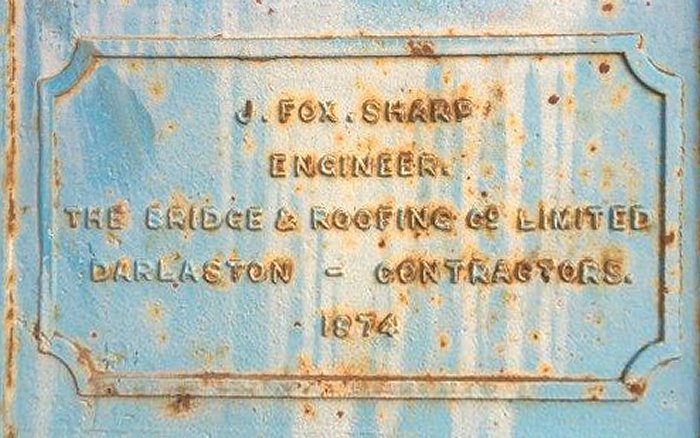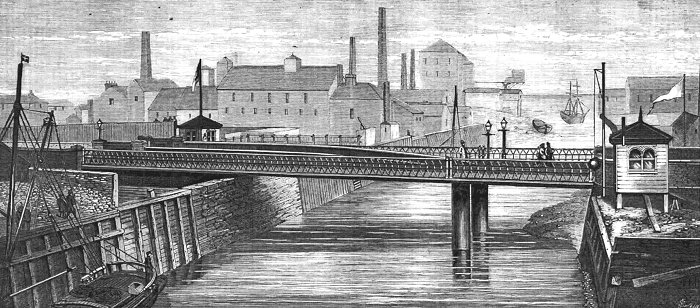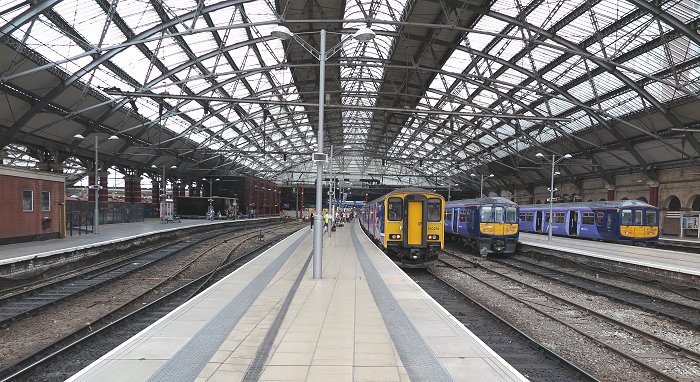|
The Darlaston Iron
Bridge and Roofing Company Limited |
|
One of Darlaston’s once large
industries was the manufacture of structural iron and
steel work. Many of the country’s important buildings
and structures were built using locally made
fabrications. Darlaston based company’s including Rubery
Owen and E. C. & J. Keay Limited were known throughout
much of the world.
The industry started in the town in
the 1840s in the first large factory in the area; King's
Hill Works, that was owned and run by S & R Carter.
Sadly the business ended in 1866 because the bank used
by the firm, the Birmingham Banking Company, suffered
serious liquidity problems and ceased to trade, leaving
Carters with many unpaid bills and angry creditors. As a
result the factory and contents were sold at auction in
June 1867 at the Old Castle Hotel in Pinfold Street.
The Darlaston Iron Bridge and
Roofing Company Limited was formed on 29th July 1867.
The Directors were Richard Mills, Samuel Rubery, and
James Slater. John Tunner Rubery became Company
Secretary, and Simeon Carter was Works Manager.
It is likely that the new company
acquired at least part, if not the whole of S & R
Carter’s Kings Hill Works to enable work to immediately
go ahead on several important orders including the
wrought ironwork for the roof of Liverpool Lime Street
Station. In 1867 to 1868 the station was lengthened and
widened. The northern-most bay of the roof, designed by
the London & North Western Railway’s Chief Engineer,
William Baker, was built at that time. Seven years later
the southern bay, also designed by William Baker was
added.
The roofs are 645ft long and cover
most of the platform area. The north roof was the
largest arched, single span wrought iron roof ever built
at the time. It took 2,500 tons of iron to build the
structure. The spans of the roof vary between 185ft and
215ft, with an average of 212ft. It appears that the
Darlaston Iron Bridge and Roofing Company were acting as
sub-contractors to G. Thompson & Company, Railway
Contractors of Liverpool, who were awarded the original
contract. The cylindrical cast iron columns were
manufactured by George Forrester & Company, Vauxhall
Foundry, Liverpool.
The roof was erected by the
Darlaston Iron Bridge and Roofing Company under the
watchful eye of the company’s Forman of Works, Mr. James
Kean. Work was completed in 1871 at a cost of £44,347.
|

Lime Street Station. Courtesy of Peter Carter.
|
The company may also have had a
site at Fallings Heath. In J. G. Harrod & Company’s
Postal and Commercial Directory of 1870 the company is
listed as: Darlaston Iron Bridge and Roofing Company,
Limited, Fallings Heath.
In 1871 Andrew Shirlaw, a Scottish
mechanical engineer became Managing Director of the
Darlaston Iron Bridge and Roofing Company, and by August
1872 the nominal capital had been increased to £20,000.
The shareholders were: Alexander Brogden M.P. for
Ulverston Lancashire; Simeon Carter, Works Manager;
Edward Eastwood, Wagon Builder at Chesterfield; Enoch
Horton, Nut & Bolt Manufacturer at Darlaston; Anna Wood, of St.
John’s Wood, London; Richard Mills; Samuel Rubery; John
Tunner Rubery; Samuel Rubery Junior; James Slater; and
Andrew Shirlaw.
Around 1870 the company moved to a
new factory in Station Street, Darlaston, on a site that
is roughly opposite to where Salisbury Primary School is
today. It was an ideal site lying next to the Darlaston
Branch of the London & North Western Railway, giving
easy access to much of the country. The branch line opened in
1863. This was one of the first factories in the area,
which had previously been extensively mined for coal by Batchcroft Colliery. Other factories soon appeared
including Enoch Horton’s New Alma Works which was built
next door.
|

An advert from 1872. Courtesy of Peter Carter.
|
In the 1870s the London & North
Western Railway quadrupled the West Coast Main Line
between Stafford and Crewe to accommodate more rail
traffic. Plans for the scheme were drawn-up in 1871 and
the contract for new bridges was given to William Moss &
Son, contractors and builders, based in Wolverhampton
Road, Stafford. In October 1872 William Moss asked for
tenders for the ironwork for the bridges, which amounted
to around 1,200 tons of wrought iron in main girders and
cross girders, bent plates etc. all fixed and painted.
The contract for the ironwork was
given to the Darlaston Iron Bridge and Roofing Company
in November 1872. The company had quoted the following
prices per ton: wrought iron bridges - £19, cast iron
bridges - £9.10s, and bolts - £24. The total cost of the
materials quoted came to £22,589. It was later
discovered that an extra bridge which had not been
included in the original plans was required. The
Darlaston company supplied the ironwork for the bridge
at a cost of £319.
The project was completed in 1876,
but William Moss withheld part of the payment to the
company because some cappings on the bridges had not
been supplied. This resulted in a court case in the High
Court of Justice, in London in 1877. The Darlaston
company claimed £2,843 for the capping and the extra
bridge, and a full payment totalling £25,632.
In June 1872 the company was
awarded a contract by the Liverpool Corporation Health
Committee for the ironwork for a wrought iron arched
bridge to carry Sandhills Lane over the Leeds and
Liverpool Canal. The Sandhills Bridge is still in use
today.
In 1873 Simeon Carter, Works
Manager at the Darlaston Iron Bridge and Roofing Company
left to start his own business. In 1870 he had purchased
some land at James Bridge from James Slater and Richard
Mills on which he opened a new factory under the name of
Carter, Ford and Company Limited.
The Bridge and Roofing Company
Limited
In September 1873 the Darlaston
Iron Bridge and Roofing Company became The Bridge and Roofing
Company Limited. One of the company’s projects
was the construction of Sculcoates Swing Bridge over the
river Hull, in Chapman Road, Hull. It was constructed in
1874 and is now Grade II listed. The bridge officially
opened in January, 1875.
|
 From Sculcoates Bridge.
From Sculcoates Bridge.
| From The Engineer,
2nd April, 1875.
Sculcoates Bridge,
Kingston-upon-Hull
We give this week the
first of two working drawings of the new
bridge at Kingston-upon-Hull, opened to
the public by the Mayor and Corporation
on the 9th January. The bridge is over
the River Hull, and is constructed in
two spans of 56ft. and 27ft., the wider
span being movable for the purpose of
navigation. The appearance of the bridge
is light, though at the same time its
structure is substantial.
The swinging portion of
the bridge is formed by two longitudinal
plate girders, 113ft. in length,
supporting a carriageway between them
and footways on cantilevers on each
side, and at the tail end of each girder
a cast iron counterbalance box of
ornamental design is constructed in
three compartments, the arms of Hull,
encircled with a festoon and riband,
being cast in relief on the two end
panels of the side elevation. The
introduction of a counterbalance box in
this manner gives a character to the
design, and greatly adds to the
symmetrical appearance of the structure,
and is, we believe, the first
application of this feature to a bridge
of this description.

The turning
machinery is in duplicate, and is fixed
in and under the counterbalance box,
where it gears into a rack fixed round
the circular retaining wall of the
bridge pit, and is worked by hand power
from the footpaths. The moving load, 240
tons can be opened or closed by four men
in two minutes. The motion of the bridge
whilst it is being turned is perfectly
smooth and without any perceptible
vibration. The pier in the centre of the
river consists of two cylinders 5ft.
6in. in diameter at the bottom, and 4ft.
3in, at the top, of cast iron, varying
from 1⅛in. to 1¼in. in thickness.
The method adopted
for the sinking of the cylinders was by
excavating from the interior and by
weighting. They were sunk by this means
to a depth of 22ft. below the level of
low water of ordinary spring tides, or
to about 18ft. below the bed of the
river, when a hard dry bed of the
boulder clay was reached. After being
sunk to within a few inches of the
required level, they were filled with
cement concrete, and each subsequently
weighted with a load of 96 tons, which
was kept on until the cylinders remained
perfectly stationary for 24 hours, the
north cylinder being forced into the
clay 1⅛in. during the process, and the
south cylinder 1 and 17/32in.; and it is
noteworthy that the actual depth to
which they were sunk was within 1 and
1/14in. of each other, so that the
uppermost castings, which it is usual to
leave off for adjusting any differences
in this respect, had only to be varied
to that small extent.

The strength of the bridge was tested
with most satisfactory results with a
weight of 50 tons, when the deflection
was only ¼in., and it resumed its
original level on the weight being
removed. The whole has been erected from
the design and under the immediate
superintendence of the engineer and
surveyor to the local board, Mr. J. Fox
Sharp, C.E.; the contractors for the
ironwork being the Bridge and Roofing
Company, Darlaston, and for the masonry,
Messrs. Simpson and Malone of Hull. |
|
|
In October 1874 The Bridge and
Roofing Company Limited won a contract to build a large
road bridge over the Metropolitan Railway at Farringdon
Road. The company quoted £18,250 for the work. Other
contracts included the Egremont Ferry Pier and the
floating approach to the Princes Landing Stage, including
the six sets of pontoons that supported the staging.
On 15th November 1876 the London &
North Western Railway put out for tenders for the
construction of a second shed at Liverpool Lime Street
Station. The contract was awarded to The Bridge and
Roofing Company Limited at a price of £35,840. The roof
which had spans varying from 170ft to 195ft was erected
by E.W. Ives, Civil Engineer of London. The project was
completed in the middle of 1879.
|

Lime Street Station.
In June 1883 The Bridge and Roofing
Company were awarded a contract for the building of
towpath bridges over the river Soar in Leicester for
£849. Other projects included the roof of the new
Midland Railway station built alongside Birmingham New
Street Station, covering 16,000 square yards. One of the
sub contractors for ironwork was Horton and Son,
Darlaston.
In the mid 1880s a
growing preference for the use of steel rather than iron
led to a reduction in orders and the closure of the
company in about 1886. On 25th and 27th of May 1887 much
of the
company’s machinery etc was sold in a two day sale, held
at the factory. The factory was acquired by Horton and
Sons in 1891, and the Bridge and Roofing Company
Limited was officially dissolved on 21st June, 1892.
The
company's projects included:
Liverpool Lime Street
Station North Shed 1867-71
Snow Hill Station Roof, Birmingham, around 1871
Radcliffe-on-Trent Viaduct 1872
Sandhills Bridge, Liverpool over the Leeds and Liverpool
Canal 1872-4
All the Bridges on the widening of the LNWR line from
Stafford to Crewe 1872-5
Bridge over Metropolitan Railway at junction of
Clerkenwell Road and Farringdon Road, London 1874
Egremont Ferry Pier 1874
Sculcoates Swing Bridge, Hull 1874
Floating Approach to Princes Landing Stage, Liverpool
1875
Birkenhead Station Roof 1878
Liverpool Lime Street Station South Shed 1876-1879
Birmingham New Street Station, Midland Railway terminal
1884
|
| I have to thank Peter Carter, who supplied much of the
information. He has extensively researched his family and
their various business ventures. |
 |
Return to
the
previous page |
|

